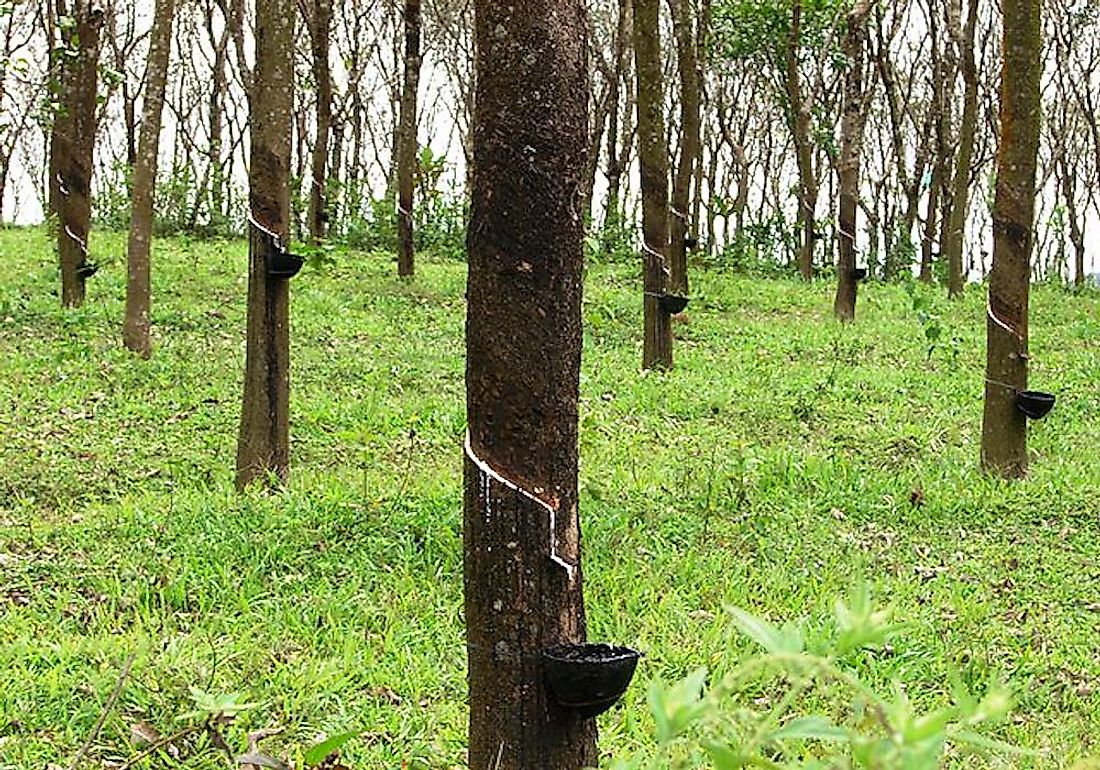The Leading Natural Rubber Producing Countries In The World

Natural rubber or India rubber is a polymer of isoprene, an organic compound. Minor impurities of other organic compounds are also found. A number of nations in Southeast Asia and India are the top producers of natural rubber in the world. The rubber products of commercial significance are produced by processing the latex collected from the rubber tree. The material is useful for its high resilience, waterproof properties, and large stretch ratio.
The Sources Of Rubber
Natural rubber comes from various sources, the most common being the Pará rubber tree (Hevea brasiliensis). It grows well under cultivation and yields latex for several years. The vines in the genus Landolphia yield the Congo rubber. These vines cannot be grown in cultivation and this led to large-scale exploitation of the wild plants in Congo. Latex is also present in dandelion milk which can be used to produce rubber. Several other trees and plants have also been used for the production of rubber.
History Of Use Of Rubber
The indigenous cultures of Mesoamerica were the first to use rubber. Latex from the Pará rubber tree was extracted to produce rubber to be used in making balls for the Mesoamerican ballgame. The Aztec and Maya cultures later started using rubber for various purposes like making waterproof textiles and containers. On 1736, the French explorer, Charles Marie de La Condamine, introduced rubber to the French Académie Royale des Sciences. This led to the publication of the first scientific paper on rubber. In 1770, Joseph Priestley discovered that rubber could be used to scrub off pencil marks on paper. Gradually, other uses of rubber were discovered, and its usage became popular across Europe. Trade soon started between the New World and Europe. In 1876, 70,000 Pará rubber tree seed were smuggled to England’s Kew Gardens. The seeds were then transported to the countries of South Asia and Southeast Asia where the plant began to be cultivated. Vulcanization was discovered in 1839 and this led to a more widespread use of rubber.
Cultivation Of Rubber Trees
Rubber trees have an economic life period of around 32 years in plantations. The trees demand well-drained and well-weathered soils. Lateritic type, alluvial, sedimentary types, and nonlateritic red soils are best for the growth of these trees. An evenly distributed rainfall with at least 100 rainy days a year and a temperature range of about 20 to 34 °C are optimum conditions for the growth of the Hevea rubber tree. A humidity of around 80%, 2000 hours of sunshine, and absence of strong winds are also necessary for best results.
Production Of Rubber
In 2013, nearly 28 million tons of rubber was produced in the world and natural rubber accounted for 44% of this production. The price of natural rubber is thus influenced by the global crude oil price since synthetic rubber is derived from petroleum. In 2013, Thailand, Indonesia, and Malaysia together accounted for 72% of the natural rubber produced in the world. Although the Hevea tree is native to South America, cultivation there is limited due to the high prevalence of leaf blight diseases and other natural predators.
The Leading Natural Rubber Producing Countries In The World
| Rank | Area | Production Value, 2013 (in tons) |
|---|---|---|
| 1 | Thailand | 4,305,069 |
| 2 | Indonesia | 3,107,544 |
| 3 | Viet Nam | 946,865 |
| 4 | India | 900,000 |
| 5 | China, mainland | 864,806 |
| 6 | Malaysia | 826,421 |
| 7 | Philippines | 444,818 |
| 8 | Guatemala | 356,392 |
| 9 | Côte d'Ivoire | 289,563 |
| 10 | Brazil | 185,725 |
| 11 | Myanmar | 174,100 |
| 12 | Nigeria | 149,052 |
| 13 | Sri Lanka | 130,421 |
| 14 | Liberia | 74,750 |
| 15 | Cameroon | 55,605 |
| 16 | Mexico | 51,397 |
| 17 | Gabon | 22,691 |
| 18 | Ghana | 21,440 |
| 19 | Cambodia | 20,099 |
| 20 | Ecuador | 18,249 |











